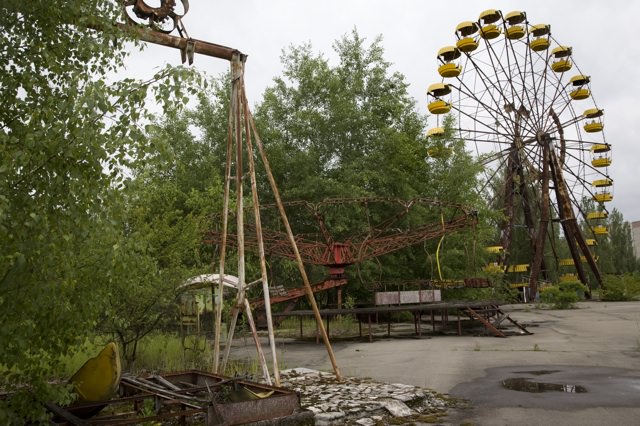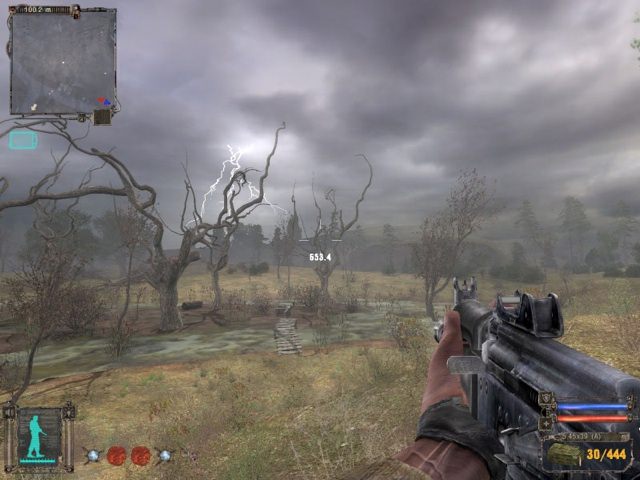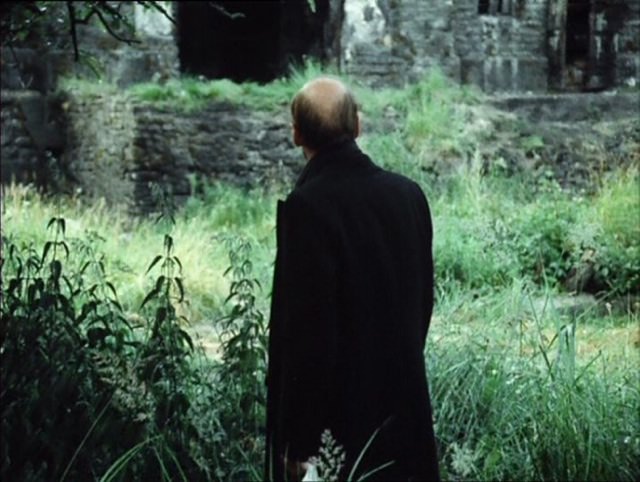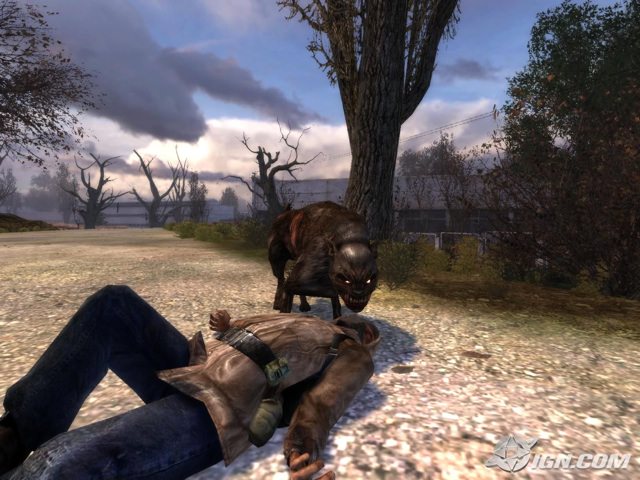Zona, Geoff Dyer’s recent book about Andrei Tarkovsky’s masterpiece Stalker, has been much discussed for its almost comically thorough dissection of the stately 1979 film. In an account that combines summary, memoir, meditation, tribute, and citation into a kind of deluxe version of the TV recap, Dyer sets out to convey the hypnotic effect Stalker has had on decades of viewers, and on himself. And yet, after reading the book, I was left feeling that something was missing. In both the book and the deluge of Stalker coverage its release has occasioned, perhaps the most crucial, and most popular, part of the film’s afterlife has gone entirely unremarked: the video game version.
It may at first seem improbable that a decades-old art film in which very little happens could be embellished with firefights and mutant psychics and converted into a violent action game. Adapted from a popular Russian science fiction novel, Stalker depicts three men (“Writer,” “Professor,” and “Stalker,” their guide and the film’s protagonist) journeying into a mysterious, dangerous “Zone,” which supposedly contains “the Room,” capable of granting wishes. This fraught, high-stakes quest consists mainly of the three men walking a couple hundred yards in a grassy, abandoned landscape and talking (with a break for a nap); the film ends after 163 minutes with no wishes apparently made or granted.
But one aspect of Stalker’s enduring fascination has been the way it seems to prefigure the Chernobyl disaster that occurred seven years after its release: the nuclear meltdown created an abandoned, radioactive “zone of alienation”—over a thousand square miles considered too radioactive to enter, though tourists began to be allowed in last year — that to many was eerily similar to the Zone of the film. It is this parallel that inspired a Ukrainian video game developer named GSC Game World to create a series of first-person shooter game adaptations of the film called, respectively, S.T.A.L.K.E.R.: Shadow of Chernobyl, S.T.A.L.K.E.R.: Clear Sky, and S.T.A.L.K.E.R.: Call of Pripyat (Pripyat is the name of the abandoned city built to house Chernobyl workers). The different “levels” or settings in the S.T.A.L.K.E.R. games are detailed (though thoroughly fictionalized) recreations of Pripyat, the cordon itself, and so on. Released between 2007 and 2010, the games have been absurdly successful; Shadow of Chernobyl alone sold several million copies around the world (and, bringing the cycle of adaptation full circle, a series of novelizations based on the game were released in Russia).
On the face of it, the games don’t have much in common with the film. A large part of the genius of Tarkovsky’s Stalker was its singular combination of mystical yearning and artistic precision. The actors, even in the midst of weighty metaphysical discussions, always seem like real people, dirty, contradictory, and changeable. Stalker is all anxious faith. The Zone is, he says, the only place he feels at home, and he knows its dangers enough to fear them utterly. Professor moves from phlegmatic commonsense to righteous violence, threatening near the end of the film to destroy the Room with a homemade bomb. While Writer, for his part, begins the film drunk and foolhardy, attempting to bring a floozy along on the expedition, and ends it in anguished, self-loathing sanity. As they move from the grimy city on the edge of the Zone to the verdant Zone itself, the cinematography switches carefully from a rough-hewn sepia to gorgeous, almost overwhelmingly lush color (Tarkovsky sometimes painted the leaves of trees to make them properly green). The soundtrack slides back and forth between an unsettling electronic score and natural sounds, often combining both.
None of this cinematic intensity or psychological depth remains in the S.T.A.L.K.E.R. games, which have subpar graphics, horrid writing, abysmal voice-acting, tasteless menus, and tediously clichéd music. Tarkovsky’s enigmatic title has been turned into a ridiculous acronym (“Scavenger, Trespasser, Adventurer, Loner, Killer, Explorer, Robber,”) and the series is ridden with technical glitches, even after a host of corrective delays and patches.
But it doesn’t really matter. As games, the S.T.A.L.K.E.R. series are remarkable, the first one especially so (few have much cared for Clear Sky). While they all have the elements of a standard action game—guns, monsters, missions, traps, loot—much of the player’s activity is oddly in keeping with Stalker’s spirit, sometimes even managing to expand upon it. Each game has an overarching plot—you’re a stranded soldier, or an amnesiac with a mission tattooed on your arm—but these are largely beside the point. The focus of the action is simply exploring: skirting battles or fighting in them, completing optional missions from other Zone residents, hunting for hidden treasure.
Advertisement
The Zone in the video games is a beautifully dangerous place, bigger and grimmer than Tarkovsky’s, but somehow still appropriate. There are plenty of long, tense walks through damp weather or empty, creaking tunnels. Packs of dogs wander the landscape, ruined farmhouses give shelter from the rain; here and there the ground ripples strangely. Stalkers gather around campfires, bandits take potshots at passersby, and a man lies wounded in a ditch, begging for help. Watching Stalker, one is occasionally brought up short by remembering that it was not filmed in Chernobyl, so perfect an analogue does that event seem for the film’s images of technology and nature, beauty and danger in strange alliance. The games, at their best, can seem like a sort of miracle: a dead man’s masterpiece, come home at last.
Yet there is something deeper that sets the series apart. Most video games are designed to unfold entirely around you, the player: everything happens for your benefit; you’re always coming into a room at the most dramatic moment, and only you can complete the mission. In many, if you simply don’t move for a few minutes, the entire world comes to a standstill. The signal new feature of the S.T.A.L.K.E.R. games, in contrast—the source at once of all those delays and bugs, and much of their unique power—was something called “A-Life,” an elaborate artificial intelligence system that populated the world with thousands of creatures and people who go about their business with no special regard for the player’s actions.
A-Life doesn’t really care about you; events take place, whether you see them or not. You’ll spend half an hour defending a friendly group from bandits, only to come back later and find they were overrun by a later attack; or you’ll accept a mission to kill a misbehaving stalker, only to find he’s been killed by a wild dog a mile away. These events—and many more that you may never find out about—emerge from the complex set of goals (find treasure, for instance, or sleep) and behaviors (shoot, trade, wander aimlessly) that A-Life provides for every character and creature throughout the game.
In some ways, the video games are closer to Tarkovsky’s source material than to Tarkovsky.
In the Strugatsky brothers’ Roadside Picnic, the science fiction book on which the movie is loosely based, the stalkers are numerous and mercenary. The elements of the Zone are many, and named, if not quite explained—there’s “Mosquito Mange” and “Burning Fluff,” “Full Empties” and “Black Sprays.” In the film most of these are not present—Tarkovsky leaves in only one, the “meatgrinder,” though his Stalker is clearly terrified of many more. But the video game returns them, and adds more: strange traps known as “anomalies,” that crush, dismember, and electrocute; and “artifacts,” weird little objects with supernatural properties—infinite batteries, death rays, and so on—which are the reason people venture into the Zone. (In Roadside Picnic both the anomalies and the “artifacts” are discarded alien technology; in the games they are somehow the result of the nuclear meltdown.)
One of the lasting enigmas of Tarkovsky’s film is the odd, intense expression—at once consumed with worry and lit up like a child’s, or a fanatic’s—worn by the actor who plays Stalker. After playing the video game, it suddenly makes a new kind of sense: It’s your face, rapt in front of a screen, playing. The games’ first-person perspective and open-ended structure have a similar effect. You can go more or less where you want, provided you don’t get poisoned by radiation, shot by bandits, or mauled by mutant dogs on the way; it’s just you and your gun, and no one, not even the game, seems to care what happens to you. Eventually the silly central plot kicks in and all this goes by the wayside, but until then, the game’s indifference can seem a kind of grim, bracing rejoinder to the smug exceptionalism that defines American games: in S.T.A.L.K.E.R. you aren’t special, you’re just there.





